Growing compact tea herbs in small spaces lets you enjoy fresh flavors and health benefits right at home. They're perfect for balconies, patios, or even windowsills. You don't need a large garden; these herbs thrive in pots, making urban gardening easy and accessible. They require less maintenance too, so you can focus more on enjoying your tea blends rather than tedious upkeep. Plus, you can experiment with unique flavors for your culinary creations. If you're enthusiastic to learn how to cultivate these herbs successfully, you'll find plenty of tips and tricks ahead.
Benefits of Compact Herbs

Compact herbs offer a range of benefits that make them an excellent choice for both novice and experienced gardeners.
First, their smaller size means you can grow them in limited spaces, like balconies, patios, or even windowsills. This versatility allows you to create a vibrant herb garden without needing a large yard.
Additionally, compact herbs often require less maintenance. They tend to be more manageable, allowing you to easily prune or harvest without feeling overwhelmed.
You'll find that they're often more resilient, thriving in a variety of conditions, which makes them perfect for those just starting out.
Another advantage is their potency. Many compact herbs pack a flavorful punch, making them ideal for culinary use.
You can enjoy fresh flavors in your dishes, enhancing your cooking without needing to buy store-bought herbs that mightn't be as fresh.
Ideal Tea Herbs for Small Spaces
When you're looking to grow tea herbs in small spaces, certain varieties stand out for their adaptability and flavor.
These compact herbs not only thrive in limited areas but also offer delightful tastes for your tea blends. Here are five ideal tea herbs you should consider:
- Mint: Easy to grow and incredibly fragrant, mint can thrive in pots and provide invigorating tea.
- Lemon Balm: With its lemony scent, this herb adds a zesty flavor to your brews and doesn't require much space.
- Chamomile: This tiny flower offers calming properties and can be grown in small containers, making it perfect for limited areas.
- Thyme: Known for its robust flavor, thyme can be harvested frequently, providing a unique twist to your tea.
- Basil: While often used in savory dishes, basil's aromatic leaves can infuse your tea with a sweet, herbal note.
Container Gardening Essentials

When you're setting up your container garden for tea herbs, picking the right containers is vital.
You'll also want to focus on quality soil and guarantee proper drainage to keep your plants healthy.
Let's explore how these essentials can make a big difference in your compact herb garden.
Choosing the Right Containers
Choosing the right containers is essential for successfully growing tea herbs in a compact space. The container you choose not only affects the growth of your herbs but also how well they thrive in limited areas.
Here are some key points to take into account when selecting containers for your tea herbs:
- Size Matters: Choose containers that provide enough space for roots to grow. A minimum of 6-12 inches in depth is ideal for most tea herbs.
- Material Choice: Opt for materials like clay, plastic, or wood. Each has its pros and cons, but lightweight options are great for small spaces.
- Drainage Holes: Make sure your containers have drainage holes. This prevents water from pooling, which can lead to root rot.
- Aesthetic Appeal: Select containers that complement your home decor. Attractive pots can enhance your living space while growing herbs.
- Mobility: Take into account lightweight containers that you can easily move. This allows you to reposition your herbs based on sunlight and weather conditions.
Soil and Drainage Tips
Healthy soil is the foundation of successful container gardening, especially for tea herbs. When growing these flavorful plants, you'll want to use a high-quality potting mix that provides good drainage and retains moisture.
Look for a blend specifically designed for containers, as it usually contains components like peat moss, perlite, or vermiculite, which help with aeration and drainage.
Don't forget about drainage! Make certain your containers have drainage holes at the bottom. If you're using pots without holes, consider adding a layer of gravel or small stones at the bottom to allow excess water to escape. This prevents root rot, which can be detrimental to your tea herbs' health.
You can also enhance your soil with organic matter, such as compost, which adds nutrients and improves soil structure. Just mix it into your potting soil before planting.
Remember to check the moisture level regularly; container soil tends to dry out faster than garden beds. Water your tea herbs thoroughly, but let the top inch of soil dry out between waterings. This balance guarantees your plants thrive while avoiding overwatering issues.
Happy gardening!
Vertical Gardening Techniques
If you're looking to maximize your space for growing tea herbs, vertical gardening techniques are a game changer.
You can easily utilize wall planters or vertical trellis systems to create a lush, green display.
These methods not only save ground space but also enhance air circulation and light exposure for your plants.
Utilizing Wall Planters
Maximize your growing space by utilizing wall planters, a fantastic option for cultivating compact tea herbs. These vertical gardening solutions not only save space but also enhance your garden's aesthetic.
By choosing the right wall planters, you can create a thriving herb garden right on your walls.
Here are some tips to help you get started with wall planters:
- Select the Right Planter: Choose planters designed for vertical gardening, ensuring they've proper drainage.
- Pick Herbs Wisely: Opt for compact varieties like mint, thyme, or basil, which thrive in smaller spaces.
- Consider Sunlight: Position your wall planters where they'll receive adequate sunlight—south-facing walls are often best.
- Watering Access: Make sure you can easily reach your planters for regular watering and maintenance.
- Fertilize as Needed: Use liquid fertilizers to provide your herbs with the nutrients they need for robust growth.
Vertical Trellis Systems
Wall planters are just one way to take advantage of vertical gardening; another effective option is incorporating vertical trellis systems. These systems allow you to maximize your growing space by encouraging your compact tea herbs to climb, rather than spread out horizontally.
By training your herbs like mint, basil, or chamomile up a trellis, you create an eye-catching display while keeping your garden organized.
When setting up a vertical trellis, choose a sturdy structure that complements your space. You can use wood, metal, or even repurposed materials to create a unique design.
Position your trellis in a spot that receives ample sunlight, ensuring your tea herbs thrive. As your plants grow, gently guide them onto the trellis using ties or clips to keep them secure.
Vertical trellis systems not only free up ground space but also promote better air circulation, which can help reduce diseases. Plus, they make harvesting easier—just reach up for fresh herbs!
Windowsill Herb Gardens

Creating a windowsill herb garden is an excellent way to enjoy fresh flavors right in your kitchen. Not only does it enhance your cooking, but it also brings a touch of nature indoors. You don't need a lot of space or fancy equipment—just a sunny spot and a few pots.
Start by choosing your favorite compact tea herbs like mint, chamomile, or lemon balm. These herbs thrive in small containers and can transform your dishes or beverages. Make certain your pots have good drainage and use quality potting soil to help your herbs flourish.
Here are a few tips to make the most of your windowsill herb garden:
- Select the Right Spot: Choose a location that gets at least 4-6 hours of sunlight daily.
- Water Wisely: Keep the soil moist but not soggy; overwatering can lead to root rot.
- Regular Harvesting: Pick leaves regularly to encourage growth.
- Fertilize Occasionally: Use a diluted liquid fertilizer every few weeks to boost nutrition.
- Rotate Pots: If you have multiple herbs, rotate them to make certain of even sunlight exposure.
With a little care, your windowsill garden will thrive and provide fresh herbs for your culinary adventures!
Hydroponic Systems for Herbs
If you're looking to enhance your herb-growing game, hydroponic systems might be just what you need.
They offer numerous benefits, like faster growth and less space requirement, making them perfect for compact tea herbs.
Plus, setting up a hydroponic system is easier than you might think, and you'll discover which herbs thrive best in this environment.
Benefits of Hydroponic Systems
Hydroponic systems offer a game-changing approach to growing herbs, especially for those with limited space or resources. By eliminating the need for traditional soil, you can create a more efficient, cleaner, and highly productive growing environment.
You'll find that hydroponics allows you to cultivate herbs indoors or in small outdoor areas without sacrificing quality or yield.
Here are some benefits you can enjoy with hydroponic systems:
- Space Efficiency: You can grow more herbs in less space, making it ideal for urban gardening or small apartments.
- Faster Growth: Plants often grow faster in hydroponic systems due to direct access to nutrients and water.
- Water Conservation: Hydroponics uses up to 90% less water than traditional gardening, making it a sustainable choice.
- Pest Control: Indoor systems reduce exposure to pests and diseases, minimizing the need for pesticides.
- Year-Round Growth: You can grow herbs year-round, regardless of outdoor weather conditions, ensuring a continuous supply.
With these advantages, hydroponic systems can truly revolutionize your herb-growing experience!
Ideal Herbs for Hydroponics
Choosing the right herbs can greatly enhance your hydroponic gardening experience. When you're considering which herbs to grow, opt for varieties that thrive in hydroponic systems.
Basil is a top choice, as it grows quickly and can be harvested continuously. Its rich flavor also makes it perfect for culinary uses.
Mint is another excellent option. It flourishes in water and can add a revitalizing touch to your teas. Just be sure to manage its growth, as it can spread rapidly.
Dill and cilantro also do well, providing unique flavors that can elevate your dishes. Both herbs have a relatively short growing cycle and can be harvested multiple times.
For a touch of spice, try growing thyme or oregano. These herbs adapt well to hydroponic environments and require minimal maintenance. They also offer strong flavors that can enhance your tea blends.
Lastly, consider growing chives. They're easy to care for, and their mild onion flavor can complement various recipes.
Setting Up Hydroponic Systems
To successfully grow herbs in a hydroponic system, you'll need to establish a setup that meets their specific needs. Start by selecting an appropriate hydroponic method, like deep water culture or nutrient film technique, depending on your space and preferences.
Make sure your system provides adequate light, as herbs thrive under consistent, bright conditions.
Here are five essential items to take into account for your hydroponic herb garden:
- Grow lights: Choose full-spectrum LED lights for ideal growth.
- Water reservoir: Use a container that holds enough water and nutrients for your plants.
- Air pump: Oxygenate the water to promote healthy root development.
- Growing medium: Opt for materials like rock wool or clay pellets to support your herbs.
- pH testing kit: Regularly check and maintain the pH level of your nutrient solution for best absorption.
Companion Planting Strategies

When growing compact tea herbs, incorporating companion planting strategies can greatly enhance your garden's health and productivity. By selecting the right companions, you can maximize space while improving growth and pest resistance. For example, pairing your tea herbs with aromatic plants like basil or marigold can help deter harmful insects, ensuring your herbs thrive.
Consider grouping herbs that share similar water and sunlight needs. For instance, pairing mint with lemon balm creates a lush, fragrant space, allowing both plants to benefit from each other's growth patterns.
Additionally, planting chamomile alongside your tea herbs can improve their flavor and aroma, as chamomile is known to enhance the overall quality of nearby plants.
Don't forget to include nitrogen-fixing plants like clover or peas in your garden. These plants enrich the soil, providing essential nutrients for your compact tea herbs.
As you plan your garden layout, visualize how each plant interacts with the others, promoting a harmonious ecosystem.
Ultimately, the right companion planting strategies can lead to healthier, more vibrant tea herbs that flourish in your small space. Embrace these strategies to get the most out of your compact herb garden.
Soil and Drainage Considerations
Healthy soil and effective drainage are essential for growing compact tea herbs successfully. When you're working with limited space, the right soil mix and drainage solutions can make all the difference.
Begin with high-quality potting soil that offers good aeration and moisture retention. You'll want to make sure your herbs thrive without getting waterlogged.
Consider these tips for ideal soil and drainage:
- Use well-draining soil: Look for mixes designed for herbs or vegetables that promote drainage.
- Add perlite or vermiculite: These materials improve aeration and help prevent compaction.
- Choose the right containers: Make certain pots have drainage holes to allow excess water to escape.
- Elevate pots: Utilize pot feet or trays to prevent sitting in water, which aids drainage.
- Test soil moisture: Stick your finger into the soil; if it feels soggy, it's time to adjust your watering schedule.
Light Requirements for Indoor Growth
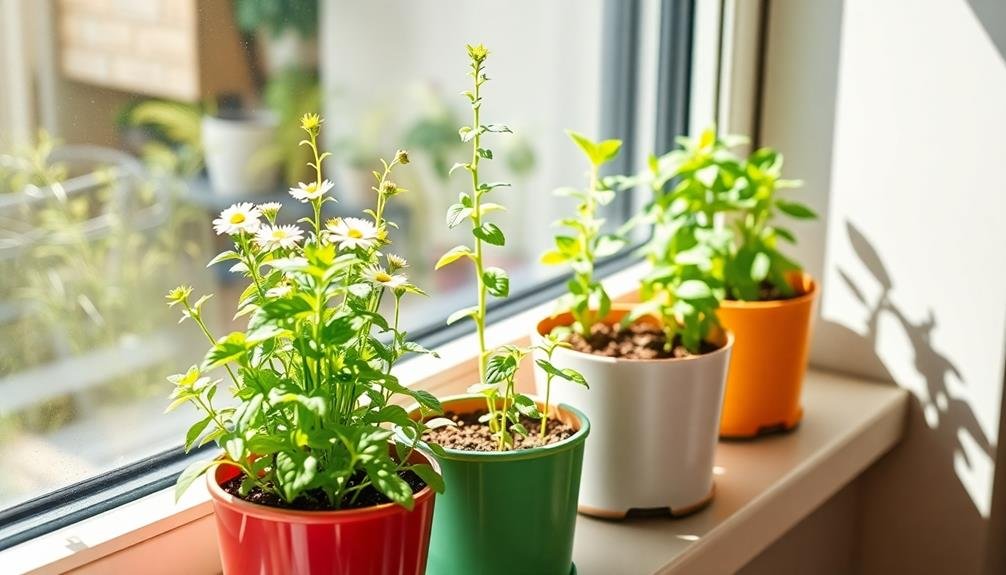
Compact tea herbs thrive best with the right amount of light, especially indoors. You'll want to guarantee they get ample sunlight, as this directly affects their growth and flavor. Ideally, place your herbs in a bright spot where they can soak up 6 to 8 hours of indirect sunlight daily. If natural light is limited, consider using grow lights to supplement.
Here's a quick guide to help you understand the light requirements for popular compact tea herbs:
| Herb | Light Needs | Notes |
|---|---|---|
| Mint | 6-8 hours | Prefers bright, indirect light |
| Chamomile | 6-8 hours | Thrives in sunny spots |
| Lemon Balm | 4-6 hours | Can tolerate partial shade |
| Thyme | 6-8 hours | Needs full sun for best flavor |
| Basil | 6-8 hours | Loves bright, warm conditions |
DIY Herbal Tea Blends
Creating your own herbal tea blends can be a rewarding experience that allows you to customize flavors to your liking. You can experiment with various herbs, spices, and other ingredients to discover combinations that excite your palate. Start by selecting a few herbs you enjoy, such as chamomile, peppermint, or lemon balm.
To truly elevate your tea game, consider these tips:
- Mix and Match: Combine different herbs for unique flavors. For example, chamomile pairs well with lavender for a calming blend.
- Add Spices: Incorporate spices like cinnamon or ginger for warmth and depth.
- Experiment with Ratios: Play around with the amounts of each ingredient to find the perfect balance that suits your taste.
- Try Different Bases: Use green tea or rooibos as a base to add complexity to your herbal blends.
- Store Properly: Keep your blends in airtight containers to maintain freshness and potency.
With a little creativity and experimentation, you can craft herbal teas that not only taste great but also cater to your personal preferences and wellness goals.
Enjoy the process and sip away!
Maintenance Tips for Indoor Herbs
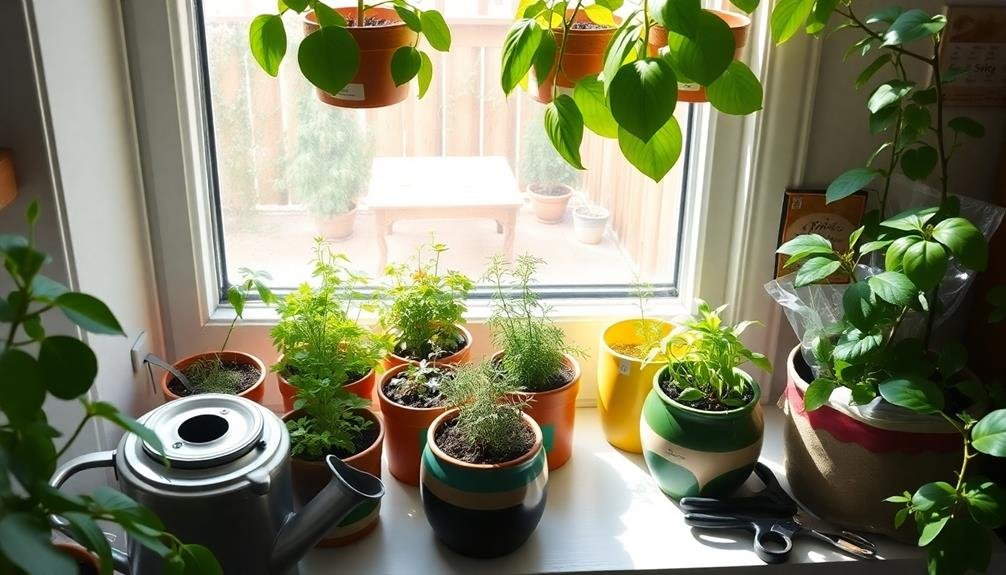
Maintaining indoor herbs requires attention and care to make certain they thrive in your home environment.
First, verify your herbs get enough light. Most herbs need at least six hours of bright, indirect sunlight daily. If you notice your plants stretching or becoming leggy, consider rotating them or supplementing with grow lights.
Watering is vital, but overwatering is a common mistake. Check the soil moisture before watering; it should dry out slightly between sessions. Use pots with drainage holes to prevent water from pooling at the bottom.
Fertilize your herbs every few weeks during the growing season with a balanced, water-soluble fertilizer. This helps provide the necessary nutrients for healthy growth.
Pruning is another essential task. Regularly trim your herbs to encourage bushier growth and prevent them from flowering too soon. Flowers can change the flavor, so snip off any blooms you see.
Lastly, keep an eye out for pests. Inspect your plants regularly for signs of infestations, such as discoloration or webbing. If you find any pests, treat them promptly with insecticidal soap or neem oil.
Frequently Asked Questions
Can I Grow Compact Tea Herbs Indoors All Year Round?
Yes, you can grow compact tea herbs indoors all year round. Just guarantee they get enough light, water them properly, and maintain a suitable temperature. With the right care, you'll enjoy fresh herbs anytime!
How Do I Prevent Pests in Small Herb Gardens?
To prevent pests in your small herb garden, regularly inspect plants, maintain cleanliness, and use natural repellents like neem oil. Encourage beneficial insects and guarantee proper air circulation to create an inhospitable environment for pests.
Are There Specific Fertilizers for Tea Herbs?
Yes, there are specific fertilizers for tea herbs. Look for organic options like fish emulsion or compost to boost nutrient levels. They'll help your herbs thrive without harming the environment—just be sure to follow application instructions!
What Are the Best Tools for Small-Space Herb Gardening?
For small-space herb gardening, you'll need a few essential tools: a trowel for planting, pruning shears for maintenance, a watering can for hydration, and pots or containers suited to your available space. Happy gardening!
How Can I Tell When My Herbs Are Ready to Harvest?
You can tell your herbs are ready to harvest by checking their size and aroma. When they're vibrant and fragrant, don't hesitate! Snip the leaves, but leave enough for the plant to keep growing.
In Summary
Growing compact tea herbs in small spaces lets you enjoy fresh flavors right at home. With the right selection of herbs, container gardening essentials, and smart techniques like vertical gardening, you can easily create a thriving indoor garden. Remember to take into account soil, drainage, and light requirements to keep your herbs healthy. By incorporating DIY herbal tea blends and following maintenance tips, you'll savor the rewards of your efforts and elevate your tea experience, all from the comfort of your space.

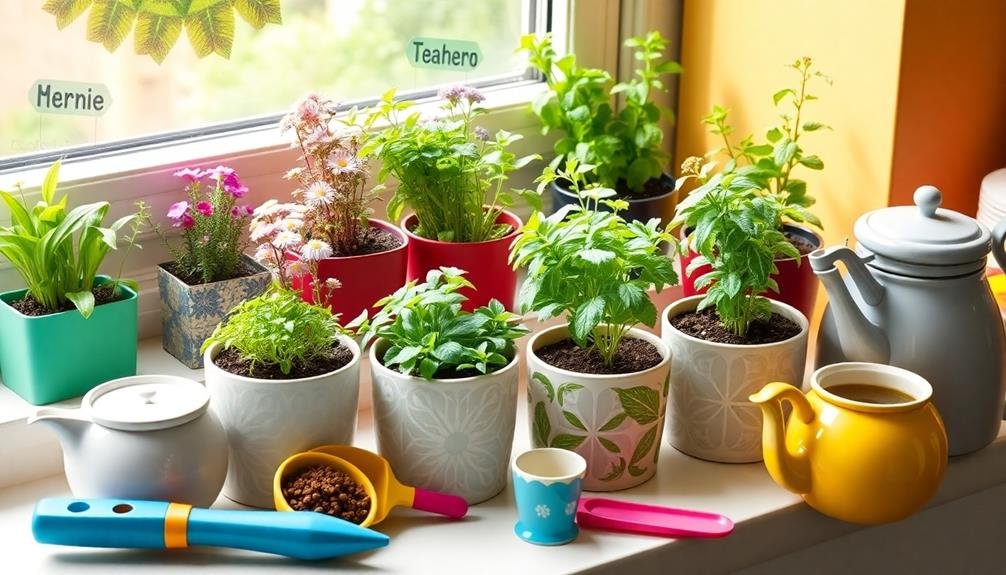
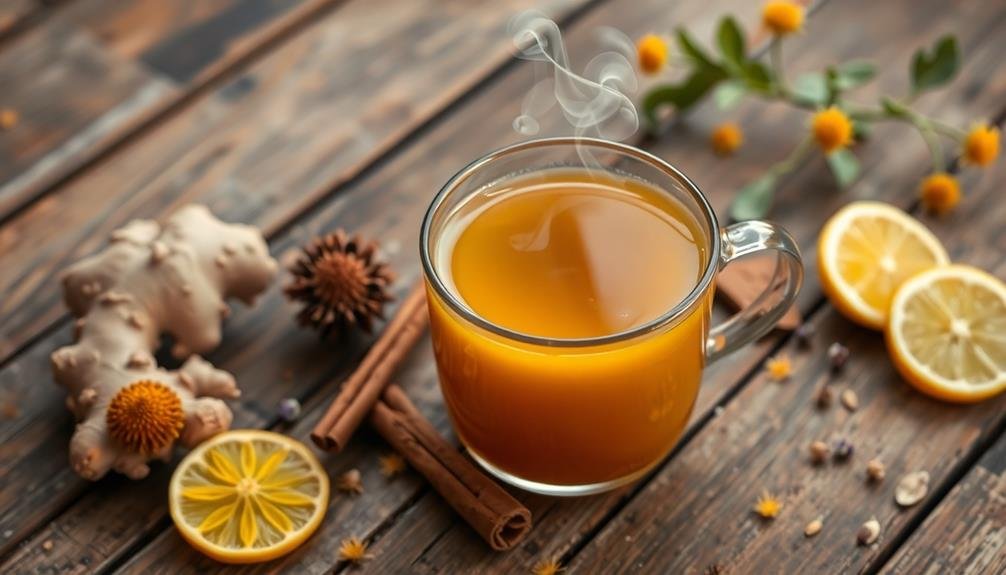
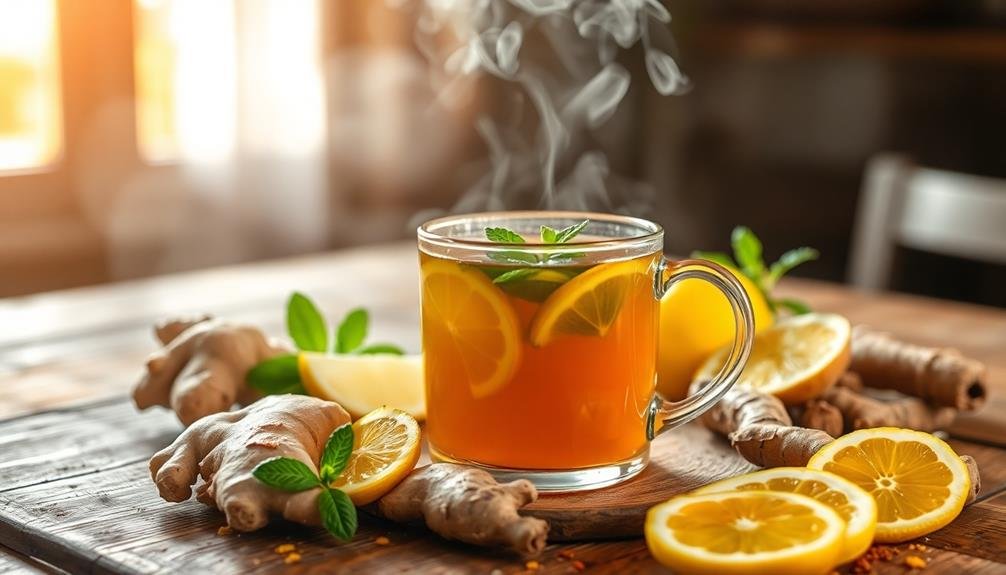
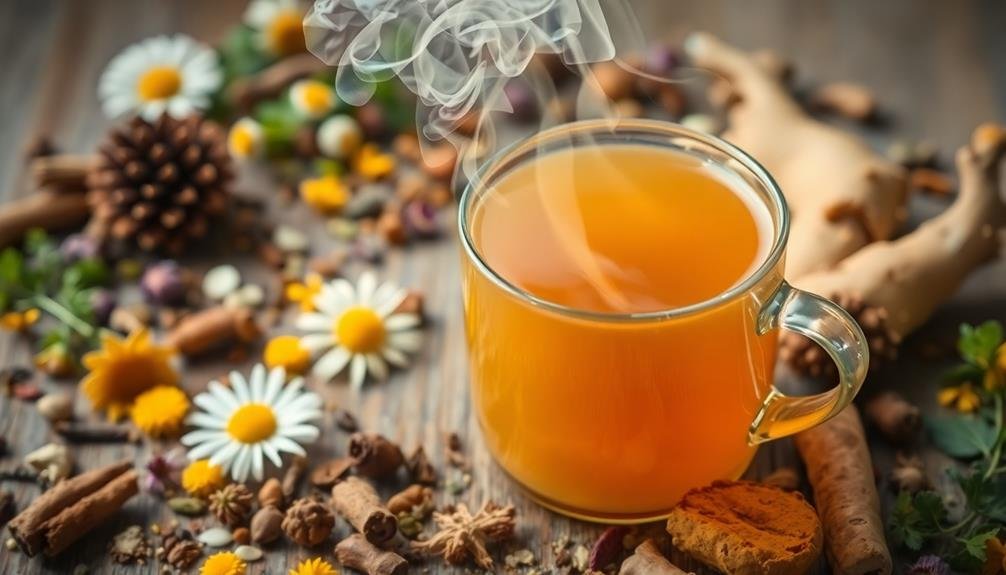
Leave a Reply